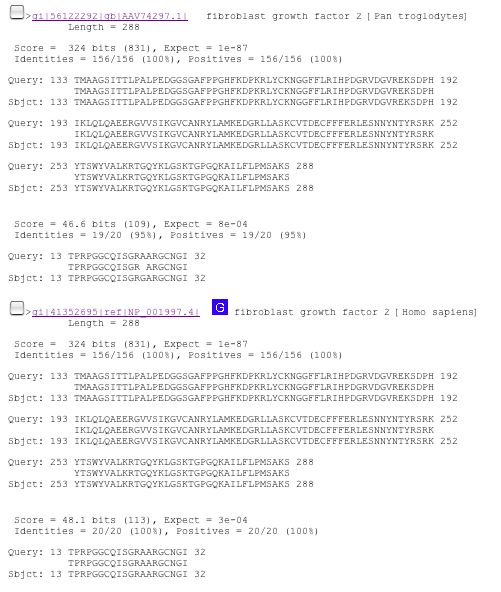This web page was produced as an assignment for an undergraduate course at Davidson College.
My Favorite Ortholog: bFGF / FGF-2
The most widely studied variant of basic fibroblast growth factor (bFGF, FGF-2) contains 288 amino acids in humans, while chickens (Gallus gallus) have only 158, rats (Rattus norvegicus) only 154, and mice (Mus musculus) also only 154. Prokaryotes do not display any orthologs for bFGF; indeed bFGF appears to be restricted mainly to upper eukaryotes, specifically vertebrates. Nevertheless, Cenorhabditis elegans displays a 425-residue protein that does have a small, but significant degree of homology to other bFGFs. (NCBI).
Sequence and Homology
1 mvgvgggdve dvtprpggcq isgraargcn gipgaaawea alprrrprrh psvnprsraa
61 gsprtrgrrt eerpsgsrlg drgrgralpg grlggrgrgr apervggrgr grgtaapraa
121 paargsrpgp agtmaagsit tlpalpedgg sgafppghfk dpkrlyckng gfflrihpdg
181 rvdgvreksd phiklqlqae ergvvsikgv canrylamke dgrllaskcv tdecffferl
241 esnnyntyrs rkytswyval krtgqyklgs ktgpgqkail flpmsaks
Figure 1. The full amino acid sequence of human bFGF, as listed in NCBI.
134 maagsittlp alpedggsgaf ppghfkdpkr lycknggffl rihpdgrvdg vreksdph 193 (homo sapiens)
001 maasgitslp alpedgg*aaf ppghfkdpkr lycknggffl rihpdgrvdg vreksdph 58 (mus musculus)
Figure 2. Comparison of a 59 amino acid sequence from human bFGF and the first 58 residues of mouse bFGF. Of the 58 amino acids in the mouse protein, 55 identical to the human ortholog, while another two residues, s4 and g5 are inverted in the human.
The highly conserved nature displayed in figure 2 would support Baird's observations that in human bFGF residues 167-211 (the paper stated 33-77 though was using a truncated form of bFGF) induced weak effects in mitogenic assays (Baird et al., 1988). Indeed, residues 134-264 display a remarkably high degree of conservation in humans, chickens and rats. Further strengthening the sequence as a possible binding site or sites is the fact that a truncated human bFGF lacking its first 49 residues and last 33 (255-288), still displays mitogenic activity (Seno et al., 1988). Peng et al. found that a difference in 5 residues between FGF-1 and bFGF (f95, s100, n102, r107, and r109) created a high-affinity binding site for fibrinogen in bFGF (Peng et al., 2004).

Figure 3. Protein-Protein BLAST for FGF-2. Humans and chimpanzees, not surprisingly, have almost identical amino acid sequences for bFGF, as both 288 residues proteins received scores of 324.
References
Baird, A., Schubert, D., Ling, N., Guillemin, R. (1998) Receptor- and Heparin-Binding Domains of Basic Fibroblast Growth Factor. PNAS 85: 2324-2328.
Seno, M., Sasada, R., Kurokawa, T., Igarashi, K. (1990) Carboxyl-terminal structure of basic fibroblast growth factor significantly contributes to its affinity for heparin. Eur J Biochem 188: 239-245.
Peng H, Sahni A, Fay P, Bellum S, Prudovsky I, Maciag T, Francis CW (2004) Identification of a binding site on human FGF-2 for fibrinogen. Blood Mar 15;103(6):2114-20.
NCBI. 2005. <http://www.ncbi.nlm.nih.gov/> Accessed 8 March 2005.